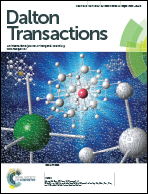Alkali metal salts of formazanate ligands: diverse coordination modes as a result of the nitrogen-rich [NNCNN] ligand backbone†
Abstract
Alkali metal salts of redox-active formazanate ligands were prepared, and their structures in the solid-state and in solution are determined. The nitrogen-rich [NNCNN] backbone of formazanates results in a varied coordination chemistry, with both the internal and terminal nitrogen atoms available for bonding with the alkali metal. The potassium salt K[PhNNC(p-tol)NNPh]·2THF (1-K) is dimeric in the solid state and even in THF solution, as a result of the K atom bridging via interaction with a terminal N atom and the aromatic ring of a second unit. Conversely, for the compounds Na[MesNNC(CN)NNMes]·2THF (2-Na) and Na[PhNNC(tBu)NNPh] (3-Na) polymeric and hexameric structures are found in the solid state respectively. The preference for binding the alkali metal through internal N atoms (1-K and 2-Na) to give a 4-membered chelate, or via internal/external N atoms (5-membered chelate in 3-Na), contrasts with the 6-membered chelate mode observed in our recently reported formazanate zinc complexes.
![Graphical abstract: Alkali metal salts of formazanate ligands: diverse coordination modes as a result of the nitrogen-rich [NNCNN] ligand backbone](/en/Image/Get?imageInfo.ImageType=GA&imageInfo.ImageIdentifier.ManuscriptID=C4DT02578D&imageInfo.ImageIdentifier.Year=2014)

 Please wait while we load your content...
Please wait while we load your content...